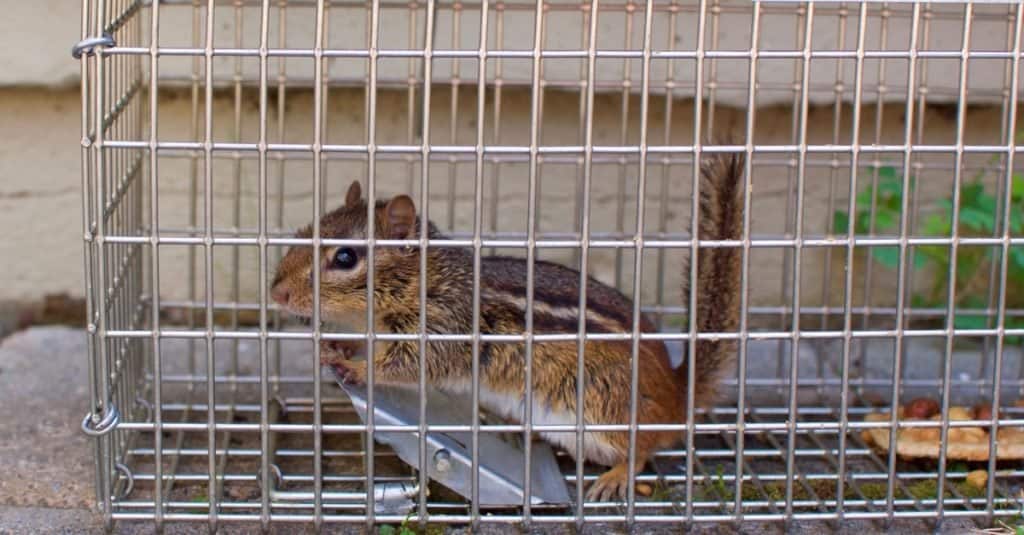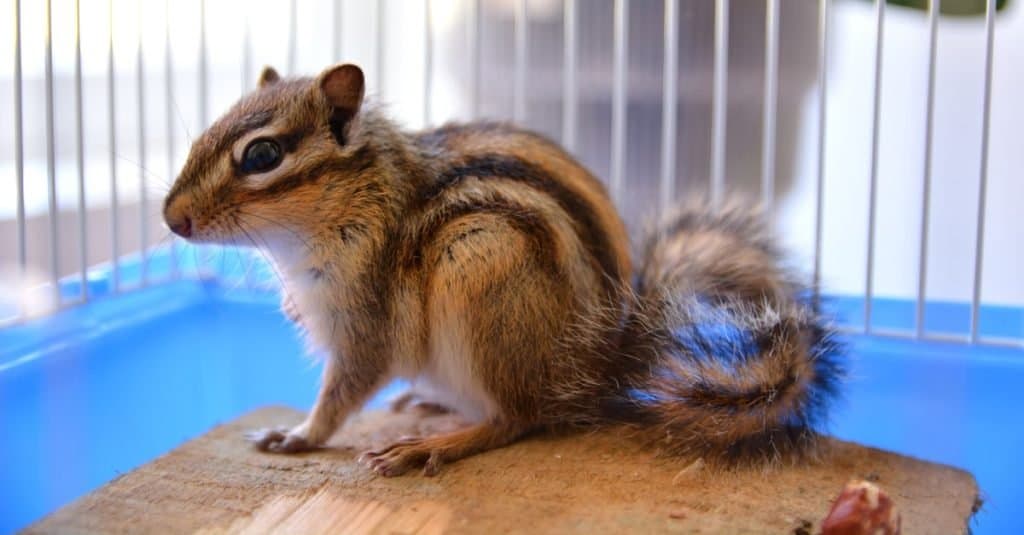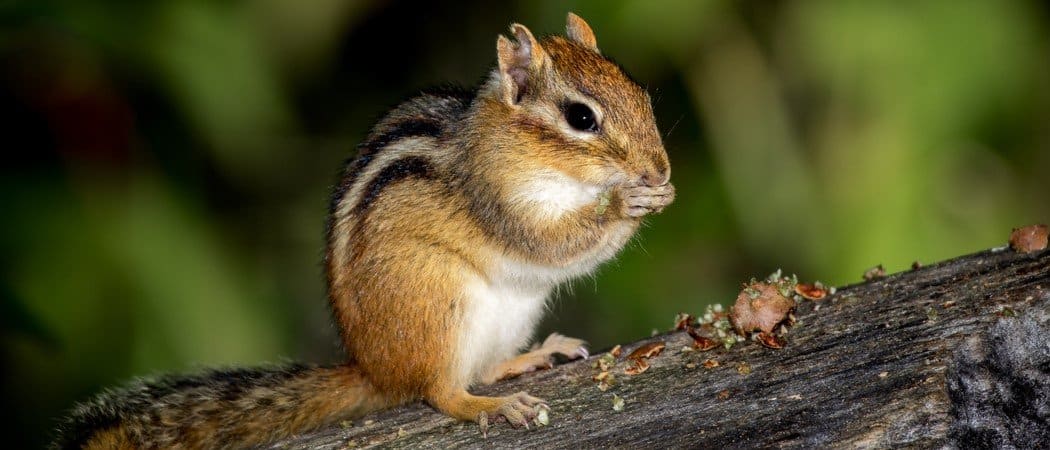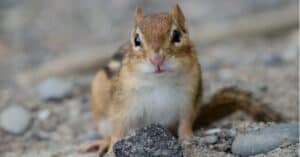Chipmunks can be a bother. You don’t want them around your yards messing up your garden or lawn. But you’re not interested in inhumane methods of getting rid of them. A simple way to remove these animals from your property is through a live chipmunk trap. Read on to get instructions and suggestions for trapping chipmunks with a live trap, as well as what to do with him after the fact.
Overview of the Chipmunk
Chipmunks are small ground dwellers are capable of wreaking havoc on property. They are identifiable by a fur of brown, yellow, and gray shading with black and white strips along the back. Chipmunks are famous for using their cheek pouches as storage, stuffing them with nuts and seeds as they forage throughout the day. The impressive tunnels chipmunks build can span up to 30 feet in length. You can sometimes hear them chirp either for mating purposes or to warn each other when a predator is near.
Chipmunks would be specifically native to North America and Canada, except there’s the Siberian chipmunk. The Siberian animal lives throughout northern Asia.
Habitats
Chipmunks prefer ground cover. They like trees, logs, shrubs, rocks, and stumps. But they are adaptable and will find cover wherever they end up. They dig burrow systems for foraging. These systems can be complex, used to nest, for spending time during the colder seasons and store food.
Once chipmunks are comfortable, it’s rare that they venture outside a third of a mile from their burrows. That means if they nest on your property, they’re here to stay.
Weighing less than five ounces, chipmunks are borrowers and a cousin to the squirrel. There are a number of species relative to the chipmunk, including woodchucks and prairie dogs.
Though preferring forested areas, like all rodents, the chipmunk is a nomad whose adventures can take it anywhere. They eat seeds and lots of fungi. The behavior spreads the mycorrhizal fungi found around tree roots. This is critical to the survival of trees. They also have a taste for nuts, grain, fruit, worms, bird eggs, nesting birds, and baby mice.
Come winter, chipmunks hibernate but don’t sleep for the entire season. They wake every couple of days and let their body temps rise to normal. They eat on their stashed food and go to the bathroom.
Property Damage
Despite their tininess, the chipmunk is capable of significant long-term damage to property. Here are some signs of damage.
- Foundational or structural harm from chipmunk burrowing
- Holes in your garden or lawn from chipmunk’s digging for plant roots
- Fallen seed piles under bird feeders
- Uprooted bulbs
- The tiny prints chipmunks leave (identifiable by their four toes in front and five in back)
Unfortunately, a lot of the chipmunk’s natural behavior is a detriment to private property. It’s why, should you find them on your property, you want to take measures to trapping chipmunks.

©Nancy Salmon/Shutterstock.com
Trapping Chipmunks: Selecting a Chipmunk Trap
There are two types of traps.
One Door
Every favors the one-door trap for its simplicity. Professionals prefer them as they allow for sound bait placement. This would be at the far end of the trap. The chipmunk enters the trap to get the bait and can’t get out.
Two Door
This device has a dual entry and promises a higher catch rate. The ability to see into the trap gives animals a sense of confidence. The trap can be set up with one or two of the doors open.
Placing a Chipmunk Trap for Trapping Chipmunks
Look around and see where you’re getting a lot of chipmunk activity. The animals like covered spaces. These areas give chipmunks security. So, look for traces of the creature in sheds, attics, underneath structures (crawlspaces, for example), below trees and near shrubbery, and in burrows.
You want to give a close look along fences and walls. Chipmunks travel along these structures, especially if there’s a cover. Keep two-door traps for trapping chipmunks going in either direction.
Selecting and Positioning Bait for Trapping Chipmunks
Never use bait the chipmunk can walk away with. Spreads like peanut butter, set directly on the trigger plate, are sound bait. If you choose to use a solid option, go with something like an unshelled peanut.
Once you have your bait, properly position it in the trap. Here’s how to set your trap.
Positioning your bait should lead to any or all of the following:
- The bait needs to force the critter to completely enter the trap.
- The chipmunk should go in far enough to step on the metal plate and trigger the trap.
- Make the best use of the one or two-door configuration.
For the single door, place bait behind the plate. Keep it away from the walls, otherwise, the chipmunk will gladly nibble or steal it without entering the trap.
For a two-door, place the bait behind the trigger. You can also bury it in the ground beneath the trap/plate or hang it from the trap’s ceiling.

©Holly Vegter/Shutterstock.com
More Tips for Expert Baiting for Trapping Chipmunks
What follows are a few suggestions for trapping chipmunks.
- Wear gloves. A chipmunk will catch the scent of humans and avoid the trap.
- You can lure a chipmunk. Create a bait trail that it will follow to the trigger plate.
- Spreads placed directly on the plate will more likely trigger the plate.
- Make sure bait doesn’t get in the way of any trap mechanisms. Give it a test. Gently press the plate to ensure doors will shut with little force.
Set the Trap
There’s a unique balance of door locks and rods in a trap that need proper setting. Carefully read instructions included with the trap. Test the trap with gentle pressure on the plate.
Note that smaller traps are sensitive to movement and vibration Once set, do your best to avoid disturbing the set trap.
Check the Trap
If you’re using the trap for humane purposes, it’s important to check the trap often. A trapped chipmunk will quickly become starved, dehydrated, or anxious.
Best Bait For Trapping Chipmunks
Traps have trigger plates that react to the weight of their prey. It’s important that you use bait that’s small and lightweight.
The chipmunk enjoys a variety of foods. Here’s a list of the best bait that catch the chipmunk’s eye or nose.
- Corn
- Raisins
- Peanut butter
- Sunflower seeds
- Pumpkin seeds
- Prune pits
- Un-roasted peanuts
- Cereal grains
You’ve Trapped a Chipmunk
Your trap worked. What now?
- Wear gloves so that you minimize direct contact with the trapped chipmunk. (Your trap has a handle. It’s best to use it.)
- When approaching and handling the trap, speak softly and gently.
- If it’s permitted (check local laws), relocate the animal no less than five miles from your home.
- After release, carefully wash and disinfect the trap. You want to prevent the spread of disease.

©Emmily/Shutterstock.com
Clean Up
Make your property less accessible and attractive. Chipmunks burrow under debris. Clear unnecessary clutter. Remove anything a chipmunk may use as cover.
A Few Tips for Clean Up
Here’s how to clean up the property, including:
- Removing brush or woodpiles. Chipmunks will use them for cover.
- Cleaning up pet food or birdseed.
- Seal potential cracks and entryways in the home.
- Keep bird feeders 15 feet away from structures. Otherwise, you risk chipmunk following spilled seed to the house.
- Consider replacing birdseed with food like thistle, a food chipmunks have no use for.
A Few Tips
- Read local laws regarding trapping chipmunks.
- The best place to put a trap is outside a burrow. This won’t be easy. Chipmunks camouflage their homes.
- If catching a chipmunk indoors, close off holes, doors, and cracks. Chipmunks will squeeze through small holes and cracks to escape to other rooms of the house.
- Chipmunks have an uncanny sense of smell. The slightest trace of humans on the trap could stop them from going in. Clean the trap after each use and always wear gloves.
- Use one part bleach and nine parts water to disinfect the trap. Wait at least 20 minutes before wiping the trap.
- Once the chipmunk’s removed, minimize their return with an animal repellent.
- Repairing screens or vents chipmunks will use to get in the house.
Repelling Chipmunks
Repelling and keeping chipmunks away requires planning. Here are a few suggestions for how to get the critters to not come near your yard or home.
Choosing a Repellent
There are a variety of options for repelling a chipmunk. If you’re dealing with an infestation, your best bet is to utilize multiple solutions to increase the chances of getting rid of the animals in the long term.
Liquid Sprays
Sprays are for direct application to bird feeders, flowers and flowerbeds, plants and trees, bulbs, woodpiles, mulch, gutters, and roofs.
Granular
Use granular repellents to cover areas where chipmunks take shelter or transverse, including crawlspace, mulch and flower beds, attics, gardens, and house perimeters.
Electronics
Bursts of water are a great way to condition chipmunks to move on. Motion-activated devices change off a variety of invaders. Install these solutions anywhere.
Line of sight is important. Most of these devices activate on sight, and chipmunks are pretty small. We suggest using electronics with other solutions, like granular and liquid repellents.
Apply as Instructed
Read and follow the instructions closely, or the repellent won’t be effective. Shake contents thoroughly for a good mix and to prevent clogging. Reapplication will be necessary. Use pumps and concentrates for large applications.
Up Next…
- Chipmunk vs. Squirrel: 7 Main Differences Explained– Chipmunks and squirrels are closely related, but squirrels are larger and live almost everywhere in the world.
- The 14 Smallest Animals in the World– The smallest rodent is 0.13 ounces, and its body is about 1.7-inches long.
- Top 10 Cutest Animals on Earth– If you’re battling chipmunks on your property, you probably don’t think they’re super cute. So here are some buddies you’ll probably find more charming.
Thank you for reading! Have some feedback for us? Contact the AZ Animals editorial team.








